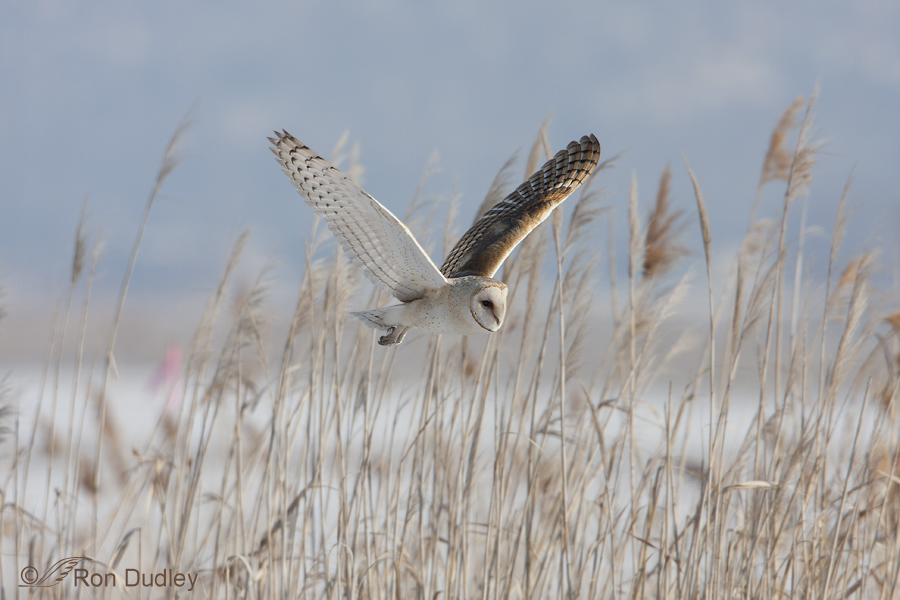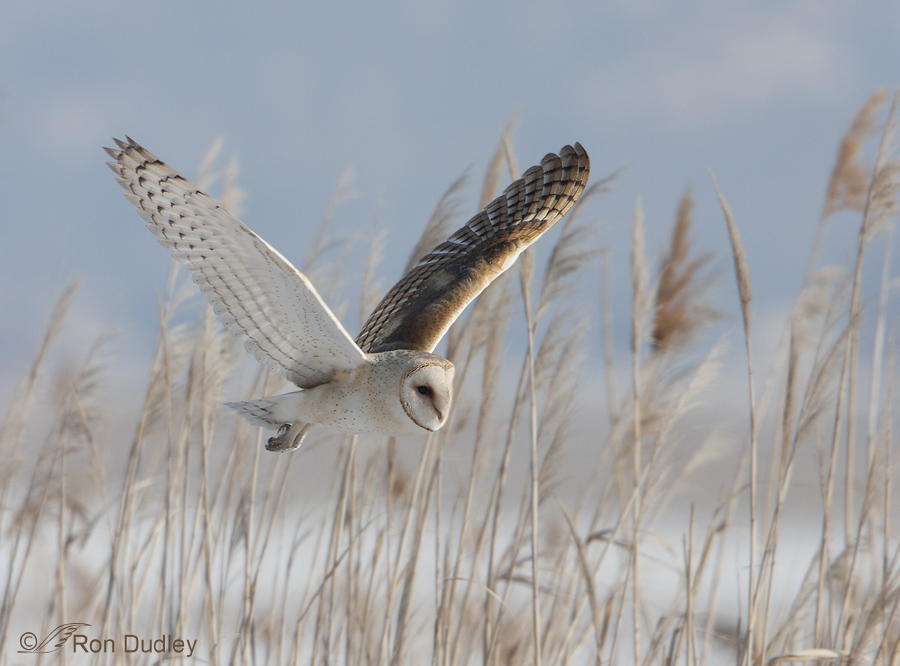It’s easy to miss the potential of a photo when viewing it full frame. This image makes me wonder how many diamonds in the rough I’ve deleted over the years…
When I get home from a morning spent in the field I face the dreaded task of culling images. On productive mornings I may take a thousand shots or more and there can be a fine line between photos I keep and those I trash. Those decisions are usually based on a cursory look as I quickly run through the photos in my photo organizer and even after all these years I occasionally miss seeing the potential of an image.

1/2000, f/8, ISO 400, Canon XTi, 500 f/4, ISO 400, 1.4 tc, not baited, set up or called in
This photo, a Barn Owl in flight at Farmington Bay, is one of my older images (2/15/08). It was taken with my first DSLR camera, the Canon XTi (boy did that tiny camera look silly attached to my huge 500mm lens!). The image file size of the XTi is 44% smaller than that of my current 7D (10.1 versus 17.9 megapixels) so I was reluctant to crop my images significantly for fear of losing too many pixels and causing image quality to suffer (a standard I didn’t have the experience to judge very well at the time). Back then I had a difficult time visualizing what the cropped image might look like.
The above version of the photo is full frame (uncropped). My heart sank when I saw the pink blob behind the bird but I immediately knew what it was – a flag put out by refuge personnel to mark stands of Phragmites that needed to be dealt with. My snap judgment at the time told me that the blob was too close to the bird to be cropped out (I didn’t want to clone it out) and that I’d be pushing the limits of image quality if I cropped it out anyway. I was wrong on both counts. (I’m actually surprised I didn’t delete the image).
Until yesterday I hadn’t even looked at this image for over six years and I had never opened it for processing.

But last night I stumbled across the image again and decided to dink around with it a little. It turns out that I could crop out the pink blob, avoid cloning and still have over 50% of the original image left. I like the wing position, the sense of environment in the setting and the wintery colors of the clouded blue sky in the far background. I do wish I had light in the eye of the owl but with this species I tend to be a little more forgiving of that deficiency because their eyes are so deeply set.
This experience makes me wonder how many images with potential I’ve deleted in the past seven years. I hope I don’t dwell on it though. I already have enough issues to keep me awake at night…
Ron


I’m very glad you kept this one – with cropping it is a gorgeous photo.
Beautiful Ron!
Charlotte
Thanks for your effort in this blog and the work it takes to keep it so interesting and inspiring. Soemday I am going to retire and do what you do. Just dont lay awake on anything, relax…..
A question on your work flow; what program do you use to preview/organize the RAW images? do you like it and recomend it?
Retirement is fantastic, Uncle Bird!
I use Photoshop CS6 for processing but prefer to use PS Elements for my organizer. I do like it and recommend it – with as many images as I have on file a highly functional organizer is of primary concern.
Nothing like a full computer to make me get on with culling.It is a fine shot, Ron and I am glad you kept it.
Thank you, Jane. I’m glad I kept it too.
A glorious capture, Ron, and I’m so glad you rediscovered it. That’s always big fun, isn’t it? Like finding your favorite sweater from a few years back tucked away in the back of the closet. Uhoh … over-sharing again, eh?? ANYway I tend to always shoot with the intent of NOT cropping … but kiddo … when it’s wildlife and that wildlife is MOVING … the cropping factor becomes very real very quickly. Good for you on giving this one a second chance!! It was worth it for sure!!!
I liked your “favorite sweater” analogy, Lois. And you’re absolutely right – final, processed images of wildlife (birds in particular) are rarely full frame. Our subjects are just too quick, skittish and uncooperative for that. I hope landscape photographers know how easy they’ve got it
So many thoughts are wheeling, whirling round in my head after seeing this post.
Firstly, as so many people have said, I am very glad you didn’t delete this.
Secondly, as a ‘happy snapper’ I would have been doing ecstatic dances if I had been privileged enough to see the owl and remembered to take a photo. Any photo.
It is all about relativities isn’t it?
And I wonder (but dismiss it instantly) whether I am too fast on delete myself.
Thanks.
Elephant’s Child, Sometimes I’m “too fast on delete” and other times I should delete more. And it gets even more complicated when you’re blogging (as you well know) because when you’re telling a story often times you need less than perfect images to do it. So when I’m culling images I have to try to figure out which ones help to tell stories (behavior, etc), which ones are worth keeping aesthetically and which ones are garbage. Reminds me of the difference between the definitions of “garbage” and “junk”, but that’s another story…
Ron, I relate to all aspects of this post! First, until recently, I shot with a 10-megapixel camera and budget lens, so not only did I not have the pixels to crop, the crops did not have the detail that my current ones do, owing to slightly better glass. Second, the culling process! It’s a bear! It’s difficult with today’s technology, to *not* come home with so many shots. And, in the context of other life obligations, culling photos tends to take on a perfunctory tone. I know when I see ten similar frames, I don’t give every single one the scrutiny in deserves. What I usually do is look for the sharpest few of the lot. I have the opposite issue you, do though. I wasn’t as diligent a culler in my early days, so now I’m going through old files and finding so many substandard ones that should have been culled. And, with my current photos, I’ve been too quick to cull because of time constraints. I hate to have huge databases to backup, with useless photos. Well, I love that you got me thinking about — and rethinking — this.
Ingrid, I can tell from your comment that you’ve gone through the drudgery of culling lots of images. It’s painful! And, as you mention, when many of them are similar it becomes even more so. You and I are “birds of a feather” (in more ways than one…)
Hello again.This is my favorite owl.Even though I have never seen one here in the northeast.. You are certainly blessed to have such an opportunity.. Wonderful image…
You’ve got that right, Gary. I’m blessed to see and photograph these owls occasionally. Something I certainly don’t take for granted.
I wouldn’t make a very good police witness…didn’t even notice the “pink blob”…my eyes went right to the bird and how beautifully the color of the phragmites and the snow echoed the subtle colors of the bird…Suchna wonderful image!!!
Thanks, Patty. That pink blob jumped right out at me but then I tend to look critically at my images…
You’re VERY hard on yourself…pat yourself on the back sometimes, too. You do such beautiful work, are sharing and teaching so us much interesting stuff, , and are a super nice guy…PLEASE be nice to Mr. Dudley. He deserves some kudos now and then from you, too!
“Pat, pat” – you’re right Patty, that felt good! And being called “Mr. Dudley” again after all these years being retired from the classroom brought back some fond memories. Thank you!
Yes, yes, yes! Some of my best shots have come from a 10th or 25th go through of frames I just couldn’t discard (too many) but didn’t think were good enough to post or print. But this is all the process of growing and maturing as a photographer and artist. We don’t know what we don’t know, but we learn and improve into whatever form of photographer we hope to be.
Well said, Rich. Sometimes I’ve looked at an image many times before I finally notice its potential.
Beautiful image Ron. I especailly love how the light hits the bottom of the left wing. You didn’t lose any quality by cropping the photo. I have a camera with 36 megapixels. Thought I didn’t have to worry about not having a 500 lens because I could crop without losing quality. ‘Forget about it’!!! I went from 300 to a 400 to make up for the loss going from DSLR to full frame and I’ll just have to live with that and try not to have to crop to the extreme. All those megapizels really don’t help!!
You’re right, Ellen – no matter how much file size you have you still lose image quality from excessive cropping. Since I shoot mostly birds (usually small subjects difficult to get close to) my cameras will always have cropped sensors instead of being full frame.
Beautiful image, Ron!
Thanks, Gail.
Yes, it’s a lovely testimony to the power of “dinking” – a magical moment distilled.
That made me smile, Alison. Thank you!
This is so beautiful. I’m glad you didn’t delete it.
So am I, Sharon. Thank you.